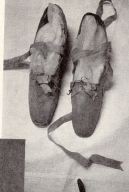
 Reinforcements
Reinforcements
Additional stitching on nineteenth-century pointe shoes did not just provide additional support for the dancer's foot. The delicate and flimsy construction of these silk-satin shoes would have meant that they rarely survived an entire performance. The fragile fabric often pulled away from the thin leather soles, even under limited strain and it would have suffered even further ravages during the rigours of the new pointe work. Even as non-ballerinas, nineteenth-century women would take more than one pair of shoes with them when attending a social engagement, such as a ball, so they could exchange their disintegrating footwear for a fresh pair (Personal Communication, S. McLean, Bata Shoe Museum, April 10, 2003). It seems likely that the darning on ballet slippers was done less for stability and more to prolong the limited life of a dancer’s footwear. The constant need to replace their pointe shoes, would have added to the ballerina’s appearance of effortlessness, erasing any signs of exercise and practice from her adornment. This may also explain why blocked pointe shoes did not appear in the ballet world until approximately 50 years after the advent of pointe work (Beaumont 1965). The necessity of looking unused made the invention of longer-lasting footwear somewhat redundant for the ballerina. Reinforcing the ideals of feminine fragility and the insubstantiality of the fantastical characters showcased in the ballets, the appearance of effortless pointe work played an integral part in the idealization and eroticization of the ballerina.